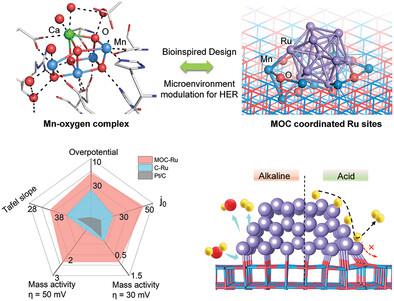当前位置:
X-MOL 学术
›
Adv. Mater.
›
论文详情
Our official English website, www.x-mol.net, welcomes your
feedback! (Note: you will need to create a separate account there.)
Mn-Oxygen Compounds Coordinated Ruthenium Sites with Deprotonated and Low Oxophilic Microenvironments for Membrane Electrolyzer-Based H2-Production
Advanced Materials ( IF 27.4 ) Pub Date : 2023-06-09 , DOI: 10.1002/adma.202303331 Chengdong Yang 1 , Zihe Wu 1 , Zhenyang Zhao 1 , Yun Gao 1 , Tian Ma 1 , Xianglin Luo 1 , Chong Cheng 1 , Yi Wang 2 , Shuang Li 1, 3 , Changsheng Zhao 1
Advanced Materials ( IF 27.4 ) Pub Date : 2023-06-09 , DOI: 10.1002/adma.202303331 Chengdong Yang 1 , Zihe Wu 1 , Zhenyang Zhao 1 , Yun Gao 1 , Tian Ma 1 , Xianglin Luo 1 , Chong Cheng 1 , Yi Wang 2 , Shuang Li 1, 3 , Changsheng Zhao 1
Affiliation

|
Among the platinum-group metals, ruthenium (Ru), with a low water dissociation energy, is considered a promising alternative to substitute Pt for catalyzing hydrogen evolution reaction (HER). However, optimizing the adsorption–desorption energies of H* and OH* intermediates on Ru catalytic sites is extremely desirable but remains challenging. Inspired by the natural catalytic characteristics of Mn-oxygen complex, this study reports to design Mn-oxygen compounds coordinated Ru sites (MOC-Ru) with deprotonated and low oxophilic microenvironments for modulating the adsorption–desorption of H* and OH* to promote HER kinetics. Benefiting from the unique advantages of MOC structures, including weakened HOH bond at interface, electron donation ability, and deprotonation capability, the MOC-Ru exhibits extremely low overpotential and ultralong stability in both acidic and alkaline electrolytes. Experimental observations and theoretical calculations elucidate that the MOC can accelerate water dissociation kinetics and promote OH* desorption in alkaline conditions and trigger the long-range H* spillover for H2-release in acid conditions. The outstanding activity and stability of membrane electrolyzer display that the MOC-Ru catalyst holds great potential as cathode for H2-production. This study provides essential insights into the crucial roles of deprotonated and low oxophilic microenvironments in HER catalysis and offers a new pathway to create an efficient water-splitting cathode.
中文翻译:

锰氧化合物与去质子化和低亲氧性微环境配位的钌位点用于膜电解槽制氢
在铂族金属中,钌(Ru)具有较低的水解离能,被认为是替代铂催化析氢反应(HER)的有前景的替代品。然而,优化Ru 催化位点上H *和 OH *中间体的吸附-解吸能是非常理想的,但仍然具有挑战性。受锰氧配合物天然催化特性的启发,本研究报告设计了具有去质子化和低亲氧性微环境的锰氧化合物配位Ru位点(MOC-Ru),用于调节H *和OH *的吸附-解吸,以促进HER动力学。得益于MOC结构的独特优势,包括界面上H - OH键减弱、电子供给能力和去质子化能力,MOC-Ru在酸性和碱性电解质中均表现出极低的过电位和超长稳定性。实验观察和理论计算表明,MOC可以在碱性条件下加速水解离动力学并促进OH *解吸,并在酸性条件下触发长程H *溢出以释放H 2 。膜电解槽出色的活性和稳定性表明MOC-Ru催化剂作为H 2生产阴极具有巨大的潜力。这项研究提供了关于去质子化和低亲氧性微环境在 HER 催化中的关键作用的重要见解,并提供了创建高效水分解阴极的新途径。
更新日期:2023-06-09
中文翻译:

锰氧化合物与去质子化和低亲氧性微环境配位的钌位点用于膜电解槽制氢
在铂族金属中,钌(Ru)具有较低的水解离能,被认为是替代铂催化析氢反应(HER)的有前景的替代品。然而,优化Ru 催化位点上H *和 OH *中间体的吸附-解吸能是非常理想的,但仍然具有挑战性。受锰氧配合物天然催化特性的启发,本研究报告设计了具有去质子化和低亲氧性微环境的锰氧化合物配位Ru位点(MOC-Ru),用于调节H *和OH *的吸附-解吸,以促进HER动力学。得益于MOC结构的独特优势,包括界面上H - OH键减弱、电子供给能力和去质子化能力,MOC-Ru在酸性和碱性电解质中均表现出极低的过电位和超长稳定性。实验观察和理论计算表明,MOC可以在碱性条件下加速水解离动力学并促进OH *解吸,并在酸性条件下触发长程H *溢出以释放H 2 。膜电解槽出色的活性和稳定性表明MOC-Ru催化剂作为H 2生产阴极具有巨大的潜力。这项研究提供了关于去质子化和低亲氧性微环境在 HER 催化中的关键作用的重要见解,并提供了创建高效水分解阴极的新途径。











































 京公网安备 11010802027423号
京公网安备 11010802027423号